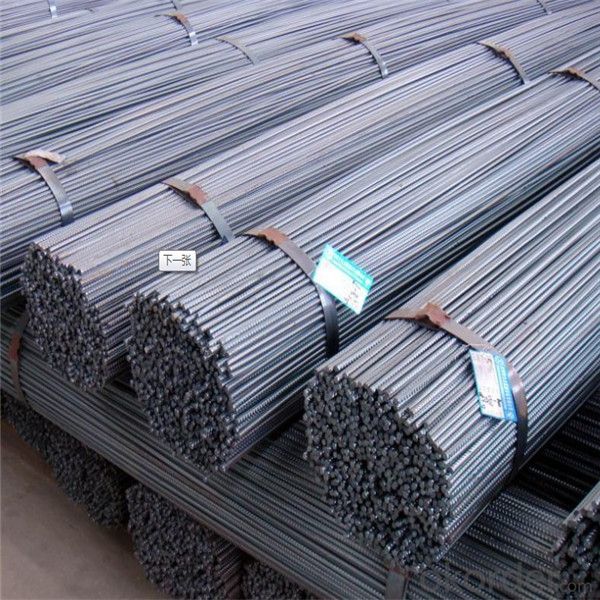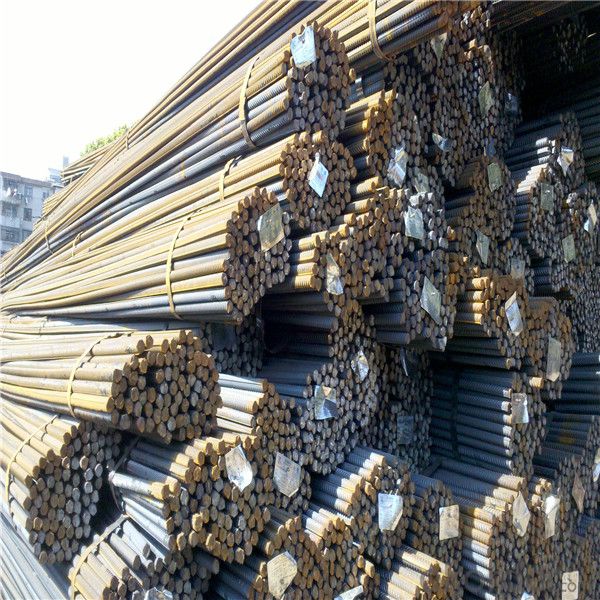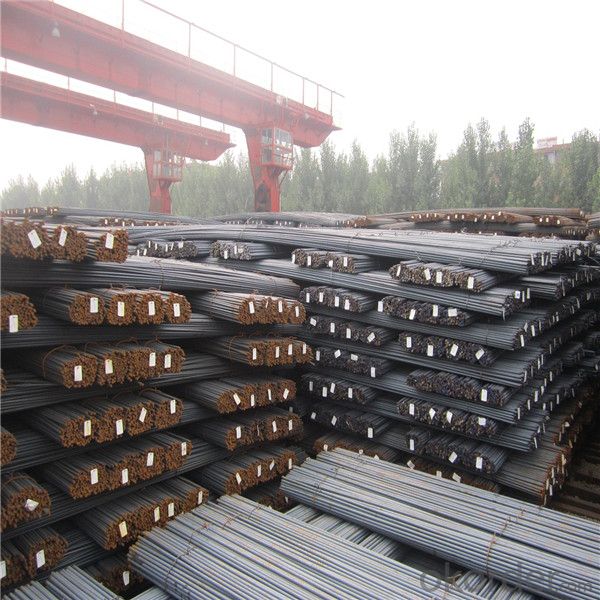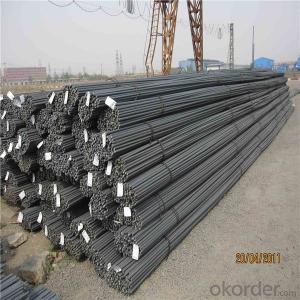Construction iron rod hot rolled for sale
- Loading Port:
- Tianjin
- Payment Terms:
- TT OR LC
- Min Order Qty:
- 1000 m.t.
- Supply Capability:
- 17497 m.t./month
OKorder Service Pledge
OKorder Financial Service
You Might Also Like
Item specifice
Steel rebar is bars of steel commonly used in construction, especially for reinforcing concrete structures such as driveways,
foundations, walls, and columns. These bars come in different sizes and strength grades, and can be smooth or may include
deformations that provide greater adhesion for concrete poured over the bars. When used in poured concrete, the bars are
typically placed in a grid pattern, the concrete poured over them, and then readjusted to maintain the proper shape while the
concrete sets. Steel rebar can be purchased from a number of manufacturers and is often found at construction retailers or
large hardware stores
Product Description :
Chemical composition (%): | Steel | C | Si | Mn | P | S | Ceq | ||||
HRB335 |
0.25 |
0.80 |
1.60 |
0.045 |
0.045 | 0.52 | |||||
HRB400 | 0.54 | ||||||||||
HRB500 | 0.55 | ||||||||||
Mechanical properties | Steel | Rel/ MPa | Rm/ MPa | A/ % | Agt/ % | ||||||
≥ | |||||||||||
HRB335 | 335 | 455 | 17 |
7.5 | |||||||
HRB400 | 400 | 540 | 16 | ||||||||
HRB500 | 500 | 630 | 15 | ||||||||
Package: | Standard export packing or as customer's request | ||||||||||
Application: | Construction, building, bridge, road. ect | ||||||||||
Payment terms | 1).100% irrevocable L/C at sight. | ||||||||||
Delivery time | 15-30 days after receipt of L/C or deposit by T/T | ||||||||||


Features
1、Pure steel quality, stable chemical contents, small tolerance.
2、Constant Quality, good drawing performance.
3、High dimension accuracy degree, accuracy degree of Level C up to 80%, smooth surface, less scale, easy to be pickled.
4、Automatic bundling with 4 lines by Machine in tidy and good looks
5、Big high quality percentage, small coil percentage, and heavy coil weight for Hard Coil.
6、High sorbitizing percentage.
Packing:
In bundles, each bundle weight 3.5 tons. Load by container or by bulk verssel.


FAQ:
1.Q: What's your MOQ(minimum order quantity)?
A: One full container, mixed acceptable .
2. Q: What's your packing methods?
A: Packed in bundle or bulk ..
3. Q: How can I buy CNBM products in my country?
A:Please send us an inquiry or email ,we will reply to you if there is distributor in your country
4. Q: Can we visit your factory?
A: Warmly welcome. Once we have your schedule, we will arrange the professional sales team to follow up your case.
5. Q: How long does it take to get the product if i place an order?
A:With the process of your requirements,we will pack and deliver in 3-7 days. If it is by sea shipment,it will take 15-45 days depending on different locations
- Q:How do steel rebars improve the structural integrity of concrete?
- Steel rebars improve the structural integrity of concrete by providing reinforcement and added strength to the material. They are embedded within the concrete, acting as a framework that helps to distribute and carry loads more effectively, preventing cracks and enhancing the overall durability and stability of the structure.
- Q:What are the different types of couplers used for connecting steel rebars?
- There are various types of couplers used for connecting steel rebars, including mechanical couplers, lap splices, and welded couplers. Mechanical couplers are commonly used due to their ease of installation and ability to provide a strong connection. Lap splices involve overlapping the rebars and tying them together with wire or other fasteners. Welded couplers, on the other hand, require the rebars to be welded together to form a connection. Each type of coupler has its own advantages and disadvantages, and the choice depends on factors such as the project requirements, rebar size, and construction method.
- Q:How do steel rebars affect the overall sustainability certifications of a structure?
- Steel rebars can have a significant impact on the overall sustainability certifications of a structure. Firstly, the use of steel rebars in construction allows for increased structural strength and durability, which can enhance the lifespan of a building. This longevity reduces the need for frequent repairs or replacements, thereby reducing waste and resource consumption. Additionally, steel rebars can be recycled at the end of a structure's life, contributing to the circular economy and minimizing the environmental footprint. Moreover, steel rebars can help improve energy efficiency by enabling the use of thinner concrete sections, reducing the amount of material required and decreasing the embodied carbon footprint. Overall, incorporating steel rebars into construction practices can positively influence sustainability certifications by promoting resource efficiency, durability, and recyclability.
- Q:What are the different types of tests conducted on steel rebars for quality assurance?
- There are several types of tests conducted on steel rebars for quality assurance. Some common tests include tensile testing, bend testing, impact testing, hardness testing, and chemical composition analysis. These tests help ensure that the rebars meet the required mechanical properties, dimensional tolerances, and chemical composition standards, ensuring their quality and suitability for various construction applications.
- Q:Are there any limitations or restrictions on using steel rebars in construction?
- Yes, there are certain limitations and restrictions on using steel rebars in construction. Here are some of them: 1. Corrosion: Steel rebars are prone to corrosion when exposed to moisture and certain chemical environments. This can weaken the rebars over time and compromise the structural integrity of the construction. To mitigate this limitation, protective coatings or stainless steel rebars can be used. 2. Fire Resistance: Steel rebars can lose their strength and become malleable when exposed to high temperatures during a fire. This can lead to structural failure. Fireproofing measures such as fire-resistant coatings or using concrete encasement can help enhance the fire resistance of steel rebars. 3. Weight: Steel rebars can be quite heavy, especially for large-scale construction projects. This can pose challenges during transportation, handling, and installation. It may require additional labor or equipment to handle the weight, which can increase project costs. 4. Thermal Expansion: Steel has a relatively high coefficient of thermal expansion, meaning it expands and contracts significantly with temperature changes. This can lead to thermal stresses and potential cracking in the concrete surrounding the rebars. Proper design techniques and the use of expansion joints can help accommodate thermal expansion and mitigate this limitation. 5. Electromagnetic Interference: Steel rebars can interfere with electromagnetic signals, such as those used in communication systems or sensitive electronic equipment. This limitation needs to be considered when constructing buildings with specific requirements, such as hospitals or laboratories. 6. Cost: The cost of steel rebars can fluctuate depending on market conditions, availability, and quality. This can impact the overall budget of construction projects, especially when large quantities of rebars are required. It is important to note that while steel rebars have limitations, they have been widely used in construction due to their strength, durability, and availability. Proper design, construction techniques, and maintenance can help overcome these limitations and ensure the safe and efficient use of steel rebars in buildings and infrastructure.
- Q:How do steel rebars impact the durability of concrete structures?
- The durability of concrete structures is significantly influenced by steel rebars. Adding steel rebars improves the strength and overall performance of concrete, making it more resistant to various external forces and extending its lifespan. To begin with, steel rebars offer structural reinforcement to concrete structures. Concrete has relatively low tensile strength, making it susceptible to cracking and failure under tensile stresses. By incorporating steel rebars into the concrete, these stresses are effectively distributed throughout the structure, preventing the formation of cracks and enhancing its load-bearing capacity. This reinforcement ensures that the concrete structure can withstand the forces it experiences, whether from gravity, wind, earthquakes, or other external factors. Additionally, steel rebars play a vital role in corrosion prevention in concrete structures. Concrete is highly alkaline, creating a protective environment for embedded steel. However, factors like moisture exposure, chloride ions, and carbonation can break down this protective layer over time, leading to steel corrosion. Corrosion weakens the rebars and causes the surrounding concrete to crack and spall, compromising the structure's durability. By using steel rebars with appropriate coatings or stainless steel, the risk of corrosion is significantly reduced, enhancing the structure's longevity and durability. Furthermore, steel rebars contribute to the durability of concrete structures by providing dimensional stability. Concrete tends to shrink and expand due to temperature and moisture changes, which can result in cracking and deformation. Incorporating steel rebars helps minimize these movements by providing restraint and stabilizing the structure, preventing excessive cracking and maintaining its integrity over time. In conclusion, steel rebars play a crucial role in enhancing the durability of concrete structures. They provide structural reinforcement, prevent corrosion, and ensure dimensional stability. By incorporating steel rebars into concrete, structures become stronger, more resistant to external forces, and have an extended lifespan. This ultimately leads to safer and more durable buildings and infrastructure.
- Q:What is the process of galvanizing steel rebars?
- Galvanizing steel rebars is a process that involves applying a protective layer of zinc to the surface of the steel rebar to prevent corrosion and extend its lifespan. The process typically involves the following steps: 1. Surface Preparation: The steel rebars are thoroughly cleaned to remove any dirt, oil, or scale on the surface. This is typically done by using a combination of chemical cleaning agents and mechanical methods such as sandblasting or shot blasting. 2. Pickling: After cleaning, the rebars are immersed in a pickling solution, usually a mixture of hydrochloric acid and water. This solution removes any remaining impurities or oxides from the surface of the rebars. 3. Fluxing: The pickled rebars are then rinsed to remove any residual acid and are immersed in a flux solution. The flux solution helps to remove any remaining oxides and ensures proper adhesion of the zinc coating. 4. Galvanizing: The fluxed rebars are then dipped into a bath of molten zinc. The temperature of the zinc bath is typically maintained between 815 to 850 degrees Fahrenheit (435 to 455 degrees Celsius). The rebars are carefully immersed and then slowly withdrawn to allow excess zinc to drain off. 5. Quenching: After galvanizing, the rebars may be quenched in a specialized solution to cool them rapidly and stabilize the zinc coating. This step helps to prevent the formation of excessive zinc oxide on the surface. 6. Inspection: Once the galvanized rebars have cooled, they undergo a thorough inspection to ensure the quality of the coating. Visual inspection, thickness measurement, and adhesion tests are commonly conducted to assess the zinc coating's integrity. Overall, the galvanizing process provides a durable and effective protective coating for steel rebars, making them resistant to corrosion and extending their lifespan in various applications such as construction, reinforcement, and infrastructure projects.
- Q:Can steel rebars be used in reinforced masonry structures?
- Yes, steel rebars can be used in reinforced masonry structures. Rebars, which are short for reinforcement bars, are commonly used to strengthen and provide structural integrity to masonry elements such as walls, columns, and beams. The rebars are inserted into the masonry units and then embedded in mortar or grout, forming a strong bond between the steel and the masonry. The use of steel rebars in reinforced masonry structures offers several advantages. Firstly, it enhances the load-bearing capacity of the structure, allowing it to withstand higher loads and resist deformation. This is especially important in areas prone to seismic activity or heavy wind loads. Secondly, the steel rebars help to distribute stress more evenly throughout the structure, preventing localized failures and increasing overall durability. Additionally, the use of rebars can improve the crack resistance of masonry, reducing the risk of cracks and improving the structural performance. It is worth noting that the design and installation of steel rebars in reinforced masonry structures must comply with specific codes and standards to ensure proper safety and performance. The size, spacing, and placement of the rebars are determined based on structural calculations and engineering principles. Adequate cover of masonry around the rebars is also crucial to prevent corrosion and maintain their structural integrity over time. In conclusion, steel rebars can definitely be used in reinforced masonry structures to enhance their strength, load-bearing capacity, and durability. Proper design, installation, and adherence to building codes are essential to ensure the successful integration of rebars with masonry.
- Q:How do steel rebars resist fire?
- Steel rebars resist fire due to their high melting point and low thermal conductivity. Steel has a melting point of around 1370°C, which is higher than typical temperatures reached in building fires. This allows rebars to maintain their structural integrity even in high-temperature environments. Additionally, steel has a low thermal conductivity, meaning it does not readily transfer heat, minimizing the risk of fire spread and structural failure. The combination of these properties makes steel rebars a reliable choice for reinforcing concrete structures in fire-prone areas.
- Q:How are steel rebars cut and bent on-site?
- Steel rebars are cut and bent on-site using specialized tools and equipment. The process typically involves the following steps: 1. Measurement: The rebars are measured according to the required length and dimensions specified in the construction plans. This is crucial to ensure accuracy and precision in the bending and cutting process. 2. Cutting: Rebars can be cut using different tools such as manual rebar cutters, hydraulic shears, or portable electric cutters. These tools are designed to provide clean and precise cuts without causing damage to the rebars. The rebars are positioned securely, and the cutting tool is applied to the marked area, resulting in the desired length. 3. Bending: Once the rebars are cut to the required length, they are bent using rebar benders. These machines have various attachments and rollers that can shape the rebars according to the desired angle and radius. The rebars are carefully positioned and secured in the bender, and the machine exerts force to bend them to the specified shape. 4. Quality control: After cutting and bending, the rebars undergo quality control checks to ensure they meet the required specifications. This may involve visual inspections, measurements, and testing to verify the accuracy of the dimensions and the quality of the cuts and bends. It is important to note that skilled workers, such as ironworkers or steel fixers, are typically responsible for the on-site cutting and bending of rebars. They have the expertise to interpret construction plans, use the appropriate tools, and ensure that the rebars are cut and bent accurately to meet the project's needs.
1. Manufacturer Overview |
|
|---|---|
| Location | |
| Year Established | |
| Annual Output Value | |
| Main Markets | |
| Company Certifications | |
2. Manufacturer Certificates |
|
|---|---|
| a) Certification Name | |
| Range | |
| Reference | |
| Validity Period | |
3. Manufacturer Capability |
|
|---|---|
| a)Trade Capacity | |
| Nearest Port | |
| Export Percentage | |
| No.of Employees in Trade Department | |
| Language Spoken: | |
| b)Factory Information | |
| Factory Size: | |
| No. of Production Lines | |
| Contract Manufacturing | |
| Product Price Range | |
Send your message to us
Construction iron rod hot rolled for sale
- Loading Port:
- Tianjin
- Payment Terms:
- TT OR LC
- Min Order Qty:
- 1000 m.t.
- Supply Capability:
- 17497 m.t./month
OKorder Service Pledge
OKorder Financial Service
Similar products
New products
Hot products
Hot Searches
Related keywords




























